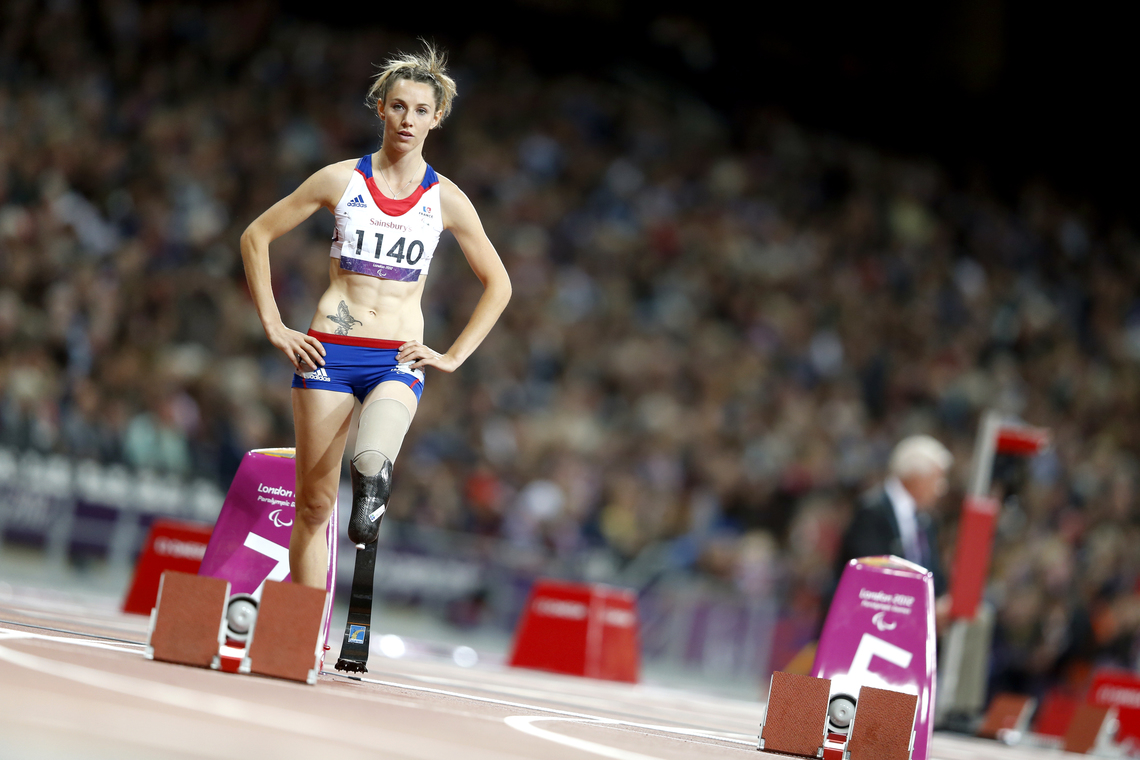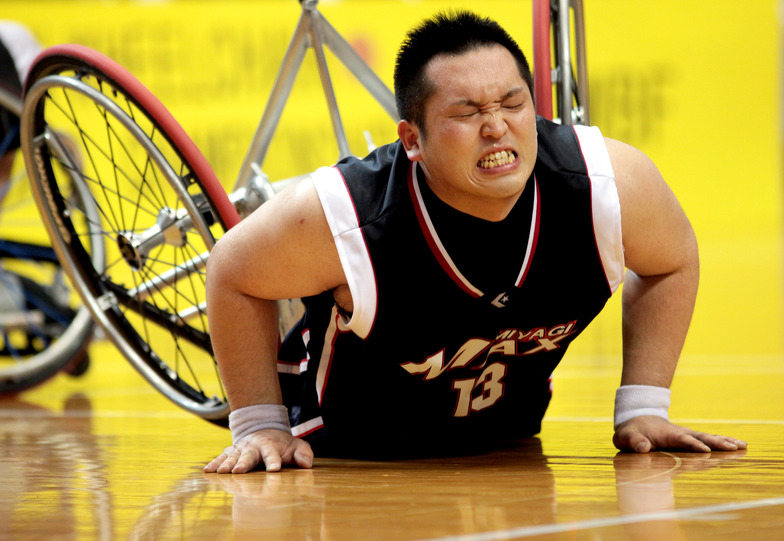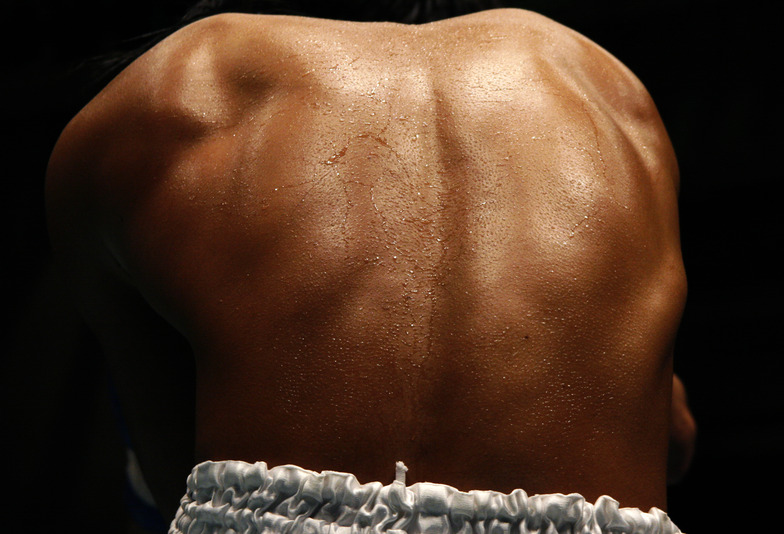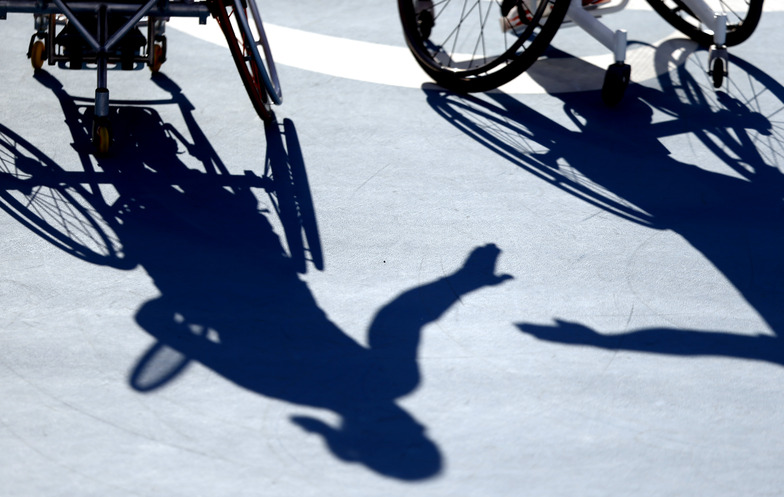Following the first part, Dentsu Inc. members (Akihiro Tani and Ami Ito), whose hearts were moved by parasports (disability sports), and photographer Shugo Takemi introduce the appeal of the Paralympics and parasports through vivid, immersive photographs.
The physical beauty of professional athletes makes you imagine their grueling training and feel a spine-tingling intensity.
Ito: Mr. Tani, could you share how you enjoy para sports?
Tani: Since I play sports myself and train hard, I can't help but notice athletes' muscles—and theirs are truly incredible.
I've heard that prosthetic runners sometimes face the misconception that they run fast simply because their prosthetics are technologically advanced. But the higher the performance of the prosthetic, the more muscle mass and training required to control it while running fast. In wheelchair basketball, for example, athletes stabilize their upper bodies using their abs rather than relying on their lower bodies.
They undergo incredibly intense training we can't even imagine. The way they build core strength is no joke. Because I train myself, I can't help but stare intently.
It's not just about records or match results; it's in that aspect of "how far they push their own bodies" that I feel their athletic spirit and have immense respect for them.
Ito: I see! That perspective on the incredible physical conditioning of athletes is something I can really relate to. When watching sports, the beauty of the muscles is definitely a point that makes me think, "Wow, that's amazing."
Tani: The London Paralympics ad "Meet the Superhumans" won an award at Cannes Lions, the world's biggest advertising event, and became a huge talking point. While the creative power and production quality are amazing, when I saw that video, I could see through each athlete's gaze and intensity – the struggles they'd overcome, the passion they poured into the competition – and it gave me goosebumps.
Ito: Takemi-san, since you often photograph athletes' bodies, do you ever notice incredible muscle development or feel a sense of physical beauty?
Takemi: Indeed, one major difference between professional and amateur athletes is how they sculpt their bodies. Top athletes truly refine their physiques right up to the end, and that professional mindset manifests in bodies that are truly beautiful. I think you could compile a photo book showcasing the physical beauty of Paralympians. Their muscle development is completely different from Olympians'.
Even in photos, I consciously shoot to make their silhouettes look instantly cool at first glance. Then, upon closer inspection, your gaze moves from their entire physique to their facial expressions, making you stare for two or three seconds. I aim for photos that you can savor gradually. I hope people find more and more ways to enjoy them.
The sight of para-athletes respecting each other and valuing their horizontal connections is truly moving.
Ito: Hearing these heart-stirring stories really shows how much you two love sports.
Are there any other points you'd like us to focus on?
Since you both know the para-athletes personally, please share what you've felt through direct interactions.
Takemi: I feel many para athletes are very approachable and talk to you very casually. After competitions, they often come over and chat with an open mind.
The relationships between athletes themselves are also incredibly close. Even something as simple as a handshake between athletes after a match carries a particularly strong meaning in Para sports. While uniform exchanges and hugs happen at the Olympics too, in Para sports, the distance is much closer. They genuinely respect each other and celebrate a good match and good play.
This is purely my impression, but I think Paralympians value harmony over individualism. Even in individual sports. I sense they strongly feel the importance of horizontal connections. They likely realize that without mutual respect as a team—among competing athletes, of course, but also with coaches, families, and friends—they can't achieve great plays or matches.
Ito: We tend to think of the Olympics as a place where the world's best athletes "compete against each other," but it's true that we should actually respect our opponents and play according to sportsmanship.
It's a very fundamental spirit, but at the Olympics, even things that might be forgotten in the rush to focus on results are held in very high regard.
Ito: This time, we heard unique stories and ways to enjoy the Games from two individuals with such passionate dedication.
Moving forward, we aim to continue this series featuring Mr. Takemi's photographs, making the Paralympics and disabled sports feel more accessible and cool to a wider audience.
Tani: That's right. Sports have a unique enjoyment that you only truly understand once you try them. We're also thinking of challenging ourselves with projects where Dentsu Inc. employees actually try the sports, gaining understanding through experience. Please look forward to that. Well then, Mr. Takemi, thank you very much.
Shugo Takemi's photo exhibition "para-graphy" is currently on display. If you're interested, please visit the venue.
●Canon Gallery Umeda: February 12 (Thu) - February 18 (Wed), 2015
●Canon Gallery Sendai: March 5 (Thu) - March 17 (Tue), 2015








